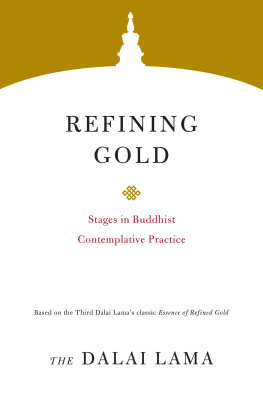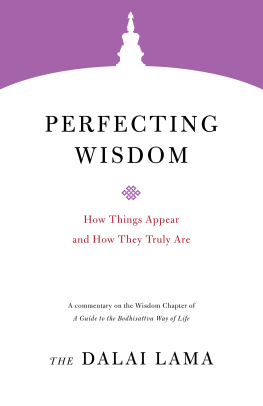COMPENDIUM COMPILATION COMMITTEE
Chair
Tromthok Rinpoche, Abbot of Namgyal Monastery
General Series Editor
Thupten Jinpa, PhD
Advisory Members
Geshe Yangteng Rinpoche, Sera Me Monastic College
Geshe Thupten Palsang, Drepung Loseling College
Gelong Thupten Yarphel, Namgyal Monastery
Editors
Geshe Jangchup Sangye, Ganden Shartse College
Geshe Ngawang Sangye, Drepung Loseling College
Geshe Chisa Drungchen Rinpoche, Ganden Jangtse College
Geshe Lobsang Khechok, Drepung Gomang College
Explore the nature of our material world in this unique sourcebook conceived by the Dalai Lama and collecting the scientific observations found in classical Buddhist treatises.
Science and Philosophy in the Indian Buddhist Classics offers a rare gift of wisdom from the ancient world to the modern reader. The editors have curated a rich treasure of the philosophy and maps of the mind that have their origins in the early centuries of Indian thought, were preserved in translation for centuries in Tibet, and now are brought to all of us in this translation.
Daniel Goleman, author of Emotional Intelligence
Science and Philosophy in the Indian Buddhist Classics will quickly become an invaluable resource for all those interested in a cross-cultural understanding of science and the history of ideas. Volume 1 offers a comprehensive treatment of the physical world drawn from the writings of Indias greatest Buddhist philosophers, with an introduction by the Dalai Lama and contextual essays by the eminent scholar Thupten Jinpa. As we seek a multicultural and global perspective on the nature of reality, this volume and those to follow will certainly make a crucial contribution.
Arthur Zajonc, emeritus professor of physics, Amherst College
The genesis of science that took place in South Asia was just as demanding in terms of empirical accuracy, explanatory standards, and theoretical ingenuity as science in the West. Unlike modern science, however, it included the experience of meditation among its basic sources of knowledge. This broadening of the empirical horizon promises to trigger a new Renaissance. We are fortunate that the editors here have offered us such a clear presentation of this exceptional resource.
Michel Bitbol, CNRS (The National Center for Scientific Research), Paris
Situated in their rich contexts by a superb set of introductory essays, these classic texts reveal a breadth of original thought and observation that presents the modern reader with challenging concepts but rewards them with novel insights.
Kevan A. C. Martin, Director, Institute of Neuroinfomatics, University of Zurich
This remarkable set of volumes will be of great interest to any student, scholar, or scientist who wishes to better understand the depth and complexity of the Indian Buddhist tradition. Surprising in their detailed consideration of the senses, particles, time, cosmology, fetal development, and the brain, these volumes are destined to become the resource for cross-disciplinary dialogue between Buddhism and science for many years to come.
Richard J. Davidson, Founder, Center for Healthy Minds, University of Wisconsin-Madison
Wisdom Publications
199 Elm Street
Somerville MA 02144 USA
wisdompubs.org
2017 The Dalai Lama Trust
All rights reserved.
A translation of Nang pai tshan rig dang lta grub kun btus, vol. 1. Dharamsala, India: Ganden Phodrang Trust (Office of His Holiness the Dalai Lama), 2014.
No part of this book may be reproduced in any form or by any means, electronic or mechanical, including photography, recording, or by any information storage and retrieval system or technologies now known or later developed, without permission in writing from the publisher.
Library of Congress Cataloging-in-Publication Data is available.
ISBN 978-1-61429-472-6 ebook ISBN 978-1-61429-492-4
21 20 19 18 17
5 4 3 2 1
Cover and interior design by Gopa & Ted2, Inc. Cover art by Getty Images. Set in Diacritical Garamond Premier Pro 11/14.
Preface

GENERAL EDITORS NOTE
THIS IS VOLUME 1 of a four-volume series that brings together classical Buddhist scientific and philosophical explorations on the nature of reality within a framework accessible to the contemporary reader. This ambitious series was conceived by His Holiness the Dalai Lama himself and compiled under his visionary supervision.
As the Dalai Lama explains in his introduction, the creation of this compilation is grounded in an understanding that it is possible to distinguish three domains in the contents of the great Buddhist treatises of classical India. First is the scientific dimension, which relates to empirical claims about not only the outer physical world but also the inner world of our experience, including the underlying principles that govern their functions and relationships. Second is the philosophical dimension, primarily statements presenting the ultimate truth or truths about reality. Finally, there is what might be called the religious dimension, which relates to Buddhist practice and the path to enlightenment. The Dalai Lama believes that, as the exchange of knowledge among the worlds cultures and languages becomes increasingly common, the insights contained in the works of the great Indian Buddhist thinkers, especially the more scientific and philosophical aspects, should be made accessible to contemporary readers.
The first two volumes in the series cover the scientific domain: volume 1 presents the physical world and volume 2 presents the mind sciences. Volumes 3 and 4 will focus specifically on the philosophical dimension of the Buddhist heritage. The remarkable accomplishment of the first two volumes is the gathering together in one place of insights of scientific interest from the great Indian Buddhist thinkers. Thanks to the Dalai Lamas vision, for the first time the contemporary reader has the opportunity to directly engage with ideas of these key Buddhist thinkers from a scientific perspective, read their own words, and follow the line of their arguments. In their original context, the presentations compiled in this series are embedded within a larger framework that includes philosophical reflections as well as the soteriological goal of awakening. The extraction and organization of these views within the framework of scientific inquiry is in itself a revolutionary achievement in the history of Buddhist thought. That all the classical sources gathered in these two volumes on science are drawn from the Tengyur the Tibetan translations of the Indian Buddhist treatises also makes this compilation an important gift to the world from the Tibetan tradition.
The Buddhist science that arose in India is as ancient as Greek science, and its methods and insights speak to us from a long bygone era. For many it is a reality that now lives only in the pages of ancient treatises, whose sounds and smells have long dissipated, and whose logic, art, and wisdom remain obscure. But equally it may be said that such impressions are misleading, for Buddhist science and its insights have relevance to us in our time. And this is not just within traditional Eastern cultures where Buddhism remains a living tradition. Buddhist science has two components: the external science of the material universe plus the internal science on the nature of the mind itself. Each relies on the other, but it is internal Buddhist science that has achieved unique and profound insights into the nature of mind, and such insights are specifically relevant to the modern world.
Next page


















